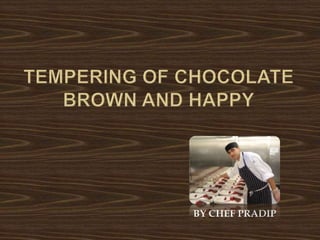Chocolate tempering
•Als PPTX, PDF herunterladen•
0 gefällt mir•2,487 views
Tempering chocolate involves controlling the crystallization of cocoa butter to ensure the chocolate has a shiny appearance and snap when broken. The process involves: 1) Melting chocolate to 45°C then cooling it to 32°C for dark or 30°C for milk/white chocolate. 2) Adding 15-20% chocolate callets at room temperature to induce crystallization. 3) Continuing to stir until the temperature reaches 34°C for dark or 33°C for milk/white chocolate to obtain properly tempered chocolate.
Melden
Teilen
Melden
Teilen

Empfohlen
Empfohlen
Weitere ähnliche Inhalte
Was ist angesagt?
Was ist angesagt? (20)
Corn Flakes Are Manufacturing Using High Quality Materials

Corn Flakes Are Manufacturing Using High Quality Materials
Ähnlich wie Chocolate tempering
Ähnlich wie Chocolate tempering (20)
Copia de biscocho de chocolate cubierto de chocolate y lacasitos

Copia de biscocho de chocolate cubierto de chocolate y lacasitos
Chocolate tempering
- 1. TEMPERING OF CHOCOLATEBROWN AND HAPPY BY CHEF PRADIP
- 2. What is tempering? The purpose of tempering chocolate is to pre-crystallise the cocoa butter in the chocolate, which is related to the working temperature of the chocolate. During tempering, the cocoa butter in the chocolate changes into a stable crystalline form. It ensures the hardness, shrinking force and gloss of the finished product after it has cooled. If the chocolate is melted in the normal way (between 40 and 45 °C) then left to cool to working temperature, the finished product will not be glossy. If you make the effort of using a special way of bringing chocolate up to the right working temperature, you are guaranteed to get the desired end result. And that is what we mean by tempering: bringing chocolate up to the right working temperature so that there are sufficient stable crystals. The 3 factors which are important during tempering are time, temperature and movement
- 3. Tempering with callets Pre-crystallisation is very easy if you add chocolate which has already been tempered to the melted chocolate. Callebaut Callets are useful for this. Callets have of course already been tempered. In other words, they are already in the required crystalline form, and can be added to the melted chocolate. The required quantity of Callets depends upon the temperature of the melted chocolate and the Callets. When the melted chocolate reaches a temperature of approximately 40 °C, you can add 15% to 20% Callets at ambient temperature (between 15 and 20 °C).
- 4. Step 1 Melt the chocolate in a melting pan (set the thermostat to 45 °C).
- 5. Step 2 Lower the thermostat (± 32 °C for dark chocolate / ± 30 °C for white chocolate and milk chocolate) and immediately add 15% to 20% Callets at ambient temperature.
- 6. Step 3 Stir the chocolate well to ensure the dispersion of the stable crystals of the Callets. Are the Callets melting too quickly? That is because the chocolate is still too hot. Add more Callets and continue stirring.
- 7. Step 4 In this way when temperature reaches, At 34°C for dark chocolate and at 33°C for milk chocolate and white. Add 1% of cocoa butter Mycryo, or 10g for 1kg of chocolate.
- 8. you will obtain a slightly thickened chocolate In order to use the chocolate over a longer period of time, Keep the thermostat it at 31-32°C for dark chocolate 29-30°C for milk, white or coloured chocolate. Which is ready to work with? Don’t forget to take the sample before start working.
- 9. THANK YOU By B&H team
